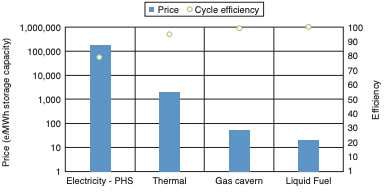Thermal Storage
Why storage?
Storage is crucial for energy systems relying on the use of renewable resources. This is due to their stochastic nature which means that although seasonal trends can be established, day-to-day electricity generation is inherently unpredictable. Moreover, the nature of heat demand is also variable due to climactic changes and peak hours of building occupation throughout the day. Storage provides a solution for ensuring a steady supply to meet the demand by charging when the renewable generation is high and discharging when it is low.
Why thermal storage?
Thermal storage involves using an insulated water storage tank to keep the temperature inside at a steady level. For district heating systems, it is favourable over electrical forms of storage such as batteries and pumped hydro storage because of its significant financial savings and its low energy losses. Indeed, the accompanying graph [1] shows that the price of thermal storage is ~2,000€/MWh capacity compared to ~200,000€/MWh for pumped hydro storage, the cheapest form of large-scale energy storage. Its cycle efficiency is 95% compared to 80%. Therefore, it is of magnitude 100 times cheaper and has energy losses of 4 times less.
Centralising the thermal storage system as opposed to having individual tanks for each building has the benefits of greater system control for the providers and less invasive maintenance and space occupation for the consumers.

Price and Cycle Efficiency of Storage Types from Lund, H. et al. (2016). Energy Storage and Smart Energy Systems. International Journal of Sustainable Energy Planning and Management, 3-14.
Time-of-use tariffs
Within a UK context, the increasing renewable and non-dispatchable portion of the grid is anticipated to lead to a growing presence of time-of-use tariffs offered when supply greatly outstrips demand[2]. This will result in consumers receiving very low electricity prices or possibly even being paid to take electricity at times with low demand. This could be a very attractive proposition for district heating suppliers with large storage capacity and could result in lower prices for customers, helping to address fuel poverty.
Modelling decisions
For the methodology, it is intended that the thermal store is charged in such a way that it minimises the carbon dioxide emissions from the development. First, by prioritising the local renewable resources from PV and curtailed wind and secondly by using grid electricity only when it drops below a specified carbon intensity threshold as described on the Carbon Intensity page.
The thermal store is modelled to meet the average heat demand of one week for the development. This is based on the low supply and return temperatures of the heat network and also includes the associated thermal losses in storage and distribution. Another approach considered was to size the tank based on the coldest week of the year but it was felt that this was unnecessary for a grid-connected development and would lead to oversizing.

Alperia Thermal Storage Tower in Bolzano, Italy from [DaRiz, O., & Filz, A. (2017, November 12). Stahlbau Pichler. Retrieved from Alperia Tower, Bolzano: https://pichler.pro/en/references?project=134]